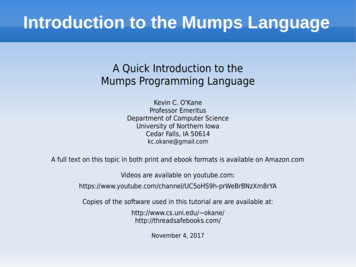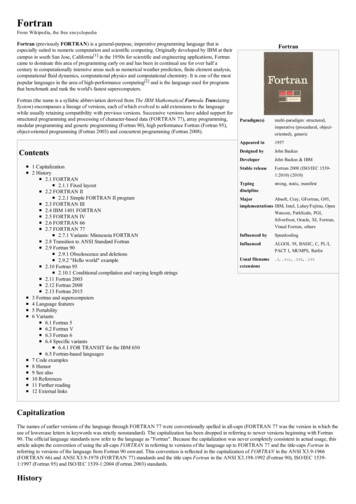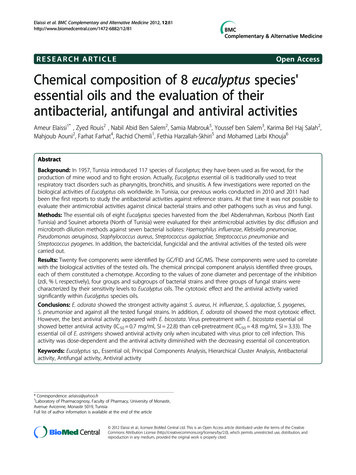
Transcription
Introduction to the Mumps LanguageA Quick Introduction to theMumps Programming LanguageKevin C. O'KaneProfessor EmeritusDepartment of Computer ScienceUniversity of Northern IowaCedar Falls, IA 50614kc.okane@gmail.comA full text on this topic in both print and ebook formats is available on Amazon.comVideos are available on 9h-prWeBrBNzXm8rYACopies of the software used in this tutorial are are available at:http://www.cs.uni.edu/ okane/http://threadsafebooks.com/November 4, 2017
Mumps History 1Mumps (Massachusetts General Hospital Utility Multi-programming System) is ageneral purpose programming language environment that provides ACID (Atomic,Consistent, Isolated, and Durable) database access by means of program levelsubscripted arrays and variables. The Mumps database allows schema-less, key-valueaccess to disk resident data organized as trees that may also be viewed as sparsemulti-dimensional arrays.Beginning in 1966, Mumps (also referred to as M), was developed by Neil Pappalardoand others in Octo Barnett's lab at the Massachusetts General Hospital (MGH) on aPDP-7, the same architecture on which Unix was being implemented at approximatelythe same time.Initial experience with Mumps was very positive and it soon was ported to a number ofother architectures including the PDP-11, the VAX, Data General, Prime, and,eventually, Intel x86 based systems, among others. It quickly became the basis formany early applications of computers to the health sciences.
Mumps History 2When Mumps was originally designed, there were very few general purpose databasesystems in existence. The origin of the term 'database' itself dates from this period.Such systems as existed, were mainly ad hoc application specific implementations thatwere neither portable nor extensible. The notion of a general purpose database designwas just developing.One of the first attempts to implement of a general purpose database system wasGE/Honeywell's initial IDS - Integrated Data Store - which was developed in the mid60s. Experience with this system lead to the subsequent creation of the CODASYLDBTG (Committee on Data Systems Languages - Data Base Task Group) whoseNetwork Model database was proposed (1969).The Network Model was very complex and was implemented, in varying degrees, byonly a few vendors. All of these were mainframe based. Most notable of these wereGE/Honeywell's IDS/2, Cullinet's Integrated Database Management System (IDMS),Univac's DMS-1100, and Digital Equipment Corporation's DEC-10 based DBMS32.
Mumps History 3At about the same time, IBM's IMS (Information Management System), was beingdeveloped in connection with the NASA Apollo program. It was first placed into servicein 1968 running on IBM 360 mainframes. IMS, which is still in use today, is, like Mumps,a hierarchically structured database.The table-based relational database model was initially proposed by E. F. Codd in 1970but it wasn't until 1974 that IBM began to develop System R, the first system to utilizethe model, as a research project. The first commercially available relational databasesystem was released by Oracle in 1979.
Mumps History 4In late 1960s mini-computers, although expensive, were becoming more widelyavailable but they were still mainly confined to dedicated, mostly laboratory,applications. The operating systems available on these systems were primitive and, forthe most part, single user. On many, the user was the operating system, flippingswitches to install boot code, and manually loading compilers, linkers and programsfrom paper or magnetic tape.DEC's RSX-11, the first commercial multi-user system on the PDP-11, was introduced in1972. RSTS/E, a time sharing system mainly used for BASIC language programming,was implemented in 1970. Other language support was limited to a small set oflanguages such as FORTRAN, BASIC and Assembly Language. Although Unix existed atthis time, it was not available outside AT&T until 1984.Thus, in 1966 when a DEC PDP-7 arrived at the Massachusetts General Hospital (MGH),there was very little in the way of software, operating system or database supportavailable for it. So, as there were few other options available, people at MGH startedfrom scratch and designed Mumps to be not only a multi-user operating system, butalso a language, and a database, all in one.
Mumps History 5For their database design, they selected a hierarchical model as this closelymatched the tree structured nature of the medical record. To represent databasetrees in the language, they decided to use array references where eachsuccessive array index was part of a path description from the root of the arrayto both intermediate and terminal nodes. They called these disk residentstructures global arrays.While in those days, Mumps, out of necessity, was its own standalone operatingsystem, this is not the case today where Mumps programs run in Unix, Linux,OS/X, and Windows based environments.The early Mumps operating system divided the very limited memory available onearly mini-computers into small partitions, each assigned to a separate user.The system allocated and managed the memory partitions and granted timeslices to each user partition usually in a round-robin protocol. The Mumpsoperating system itself provided the Mumps language interpreter (Mumps wasnot compiled), centralized I/O, and managed access to the hierarchicaldatabase through a centralized Global Array File Manager, as outlined in thefollowing figure.
Mumps History 6
Mumps History 7Memory on early mini-computers was limited, sometimes only a few thousandcharacters. Mumps programs were loaded into memory as source code rather than ascompiled binary. This was done because it was determined that compiled Mumpsprograms would be far larger than the corresponding source code versions, especially ifthe source code employed size reducing abbreviations.While interpreted programs ran slower, the time lost was more than made up by thetime saved by not needing to page in and out large binary modules which, initially, wasdone from magnetic tape. Further, as is the case with most database applications,most program time is spent waiting for database access so the interpretation overheadfactor was not really very large.As an added benefit, small source code modules used less disk space which, when itbecame available, was very expensive.
Mumps History 8The legacy of small memory machines can still be seen to this day, as Mumpsprogrammers tend to abbreviate their code, sometimes excessively, although theoriginal reason for doing so is long past.Because of its simplicity, low cost, and ease of use, Mumps quickly became popularand was used in many medical applications. COSTAR (COmputer-STored AmbulatoryRecord), for example, was a medical record, fiscal management and reporting system,developed in the mid-1970s for use in ambulatory care settings and it was widely usedand adapted worldwide.
Mumps History 9Today, Mumps programs are employed extensively in financial and clinical applications.If you've been to a doctor, been seen at a hospital, or used an ATM machine, your datahas probably been processed by a Mumps program.Mumps programs are the basis of the U.S. Veterans Administration's computerizedmedical record system VistA (Veterans Health Information Systems and TechnologyArchitecture), the largest of its kind in the world. VistA is a collection of 80 differentsoftware subsystems that support the largest medical records system in the UnitedStates. It supports the medical records of over 8 million veterans, is used by 180,000medical staff at 163 hospitals, more than 800 clinics, and 135 nursing homes.Mumps is used by many health care organizations including Allscripts, Epic, CoventryHealthcare, EMIS, Partners HealthCare (including Massachusetts General Hospital),MEDITECH, GE Healthcare (formerly IDX Systems and Centricity), Sunquest InformationSystems, DASA, Quest Diagnostics, and Dynacare, among others.
Mumps History 10Some of the largest and most well known hospitals use Mumps based electronic healthrecords systems. These include: Kaiser Permanente, Cleveland Clinic, Johns HopkinsMedicine Hospitals, UCLA Health, Texas Health Resources, Massachusetts GeneralHospital, Mount Sinai Health System in New York City and the Duke University HealthSystem.Among financial, institutions it is used by Ameritrade, the Bank of England andBarclays Bank, as well as others.
Mumps History 11Mumps has remained viable by providing: In addition to sequential and direct file access, Mumps also implements, as anintegral part of the language, a hierarchical and multi-dimensional databaseparadigm. When viewed as trees, data nodes can addressed as path descriptions ina manner which is easy for a novice programmer to master in a relatively short time.Alternatively, the trees can be viewed as sparse n-dimensional matrices ofeffectively unlimited size.Mumps supports built-in string manipulation operators and functions that provideprogrammers with access to efficient methods to accomplish complex stringmanipulation and pattern matching operations.Mumps runs on inexpensive, commodity servers and is easily scaled as demandgrows.Mumps can handle Big Data quantities of information that are beyond thecapabilities of many RDBMS systems with very high levels of performance andthroughput.Mumps is easily managed without the need for database administrators.Mumps databases are ACID (Atomicity, Consistency, Isolation, Durability)Compliant.
Mumps ImplementationsThe implementations currently available are:1. Intersystems (Caché)http://www.intersystems.com/ (called Caché )2. FIS platforms-gtm3. MUMPS Database and Language by Ray Newmanhttp://sourceforge.net/projects/mumps/4. Open Mumpshttp://www.cs.uni.edu/ okane/The dialects and extensions accepted by these implementations vary so you shouldconsult the documentation of the version you are using for further details. Theexamples used here are drawn from GPL Mumps.
Open Mumps InterpreterThe examples in this introduction were written and tested with the Open Mumps Interpreter, a free, opensource distribution for Linux licensed under the GPL V2 License. The distribution is available at:http://www.cs.uni.edu/ okane/Once installed, the interpreter may be executed in interactive command line mode by typing:mumpsTo exit, type halt. Mumps commands may be entered and executed immediately. To execute a programcontained in a file, to the interpreter type:goto filename.mpsYou may also, to a command window, type:mumps filename.mpsAlternatively, in Linux, a file of Mumps code may be executed directly if you set the file's protections toexecutable and have on its first line:#!/usr/bin/mumpsThe program may now be executed by typing its name to the command prompt.Additional documentation is available at the site referenced above.
Interpreter ExamplesThe first image shows execution of Mumps code directly in thecommand line interpreter in a Linux terminal window. Thecommand mumps invokes the interpreter and the user enters aniterative Mumps command and then exists the interpreter (halt).The second image, also a Linux terminal window, shows in the firstdivision (Contents of test.mps) a small Mumps program namedtest.mps.The program can be executed by typing it’s name as and argumentto the name of the interpreter (mumps test.mps) as shown inExample 1.The program can be executed by typing it’s name if it’s file is listedas executable and, consistent with Linux/Bash usage, on line one,the name of the interpreter to use is given (/usr/bin/mumps)(Example 2)The program can also be executed from the Mumps CLI with aMumps goto (g) command (Example 3)
Mumps Syntax WarningMumps syntax will be discussed in detail below but it is important at this time to pointout that standard Mumps code may not contain embedded blanks except within quotedstrings.In Mumps, a blank is a delimiter.set var 3*x yset var 3 * x y ; blanks not allowed
Variables 1Mumps has two types of variables: local and global.Global variables are stored on disk and continue to exist when the program thatcreated them terminates.Local variables are stored in memory and disappear when the program that createdthem terminates.A Mumps variable name must begin with a letter or percent sign (%) and may befollowed by letters, percent signs, or numbers.Variable names are case sensitive. The underscore ( ) and dollar sign ( ) charactersare not legal in variable names.Global variable names are always preceded by a circumflex ( ), local variables are not.The contents of all Mumps variables are stored as varying length character strings. Themaximum string length permitted is determined by the implementation but thisnumber is usually at least 512 and often far larger (normally 4096 in Open Mumps).
Variables 2In Mumps there are no data declaration statements. Variables are created as neededwhen a value is assigned to a variable name for the first time.Values may be assigned to variables by either a set, merge or read command.Variables may also be created if they appear as arguments to the new command.Once created, local variables normally persist until the program ends or they aredestroyed by a kill command. Global variables persist until destroyed by a killcommand.In its original implementation, Mumps did not have a means to pass parameters toinvoked routines. Consequently, to this day, variables are, ordinarily, known to allroutines.
Variables 3Mumps variables are not typed. The basic data type is string although integer, floating point andlogical (true/false) operations can be performed on string variables if their contents areappropriate.The values in a string are, at a minimum, any ASCII character code between 32 to 127 (decimal)inclusive. Some implementations permit additional character codings for other languages.In Open Mumps, some characters outside this range can be generated in write commands withthe char() function (discussed below).Variables receive values by means of the set, merge or read commands.Array references are formed by adding a parenthesized list of indices to the variable name suchas:name("abc",2,3)Indices may evaluate to numbers or strings or both. Strings constants must be quoted, numericconstants need not be quoted.
Example Variablesset % 123; a scalar local variableset x1("ducks") 123; ducks is a global arrayset fido "123"; Local variableset Fido "dog"; Names are case sensitiveset x("PI") 3.1414; x is a local array referenceset input dat 123; underscore not permittedset x 123; sign not permittedset 1x 123; must begin with a letter or %read x(100); read value into global array elementread %%123; read value into scalarread A; underscore error
String ConstantsString constants are enclosed in double quote marks (").A double quote mark itself can be inserted into a string by placing two immediatelyadjacent double quote marks ("") in the string.The single quote mark (') is the not operator with no special meaning within quotedstrings.The C/C /Java convention of preceding some special characters by a backslash doesnot apply in Mumps."The seas divide and many a tide""123.45" (means the same as 123.45)"Bridget O'Shaunessey? You're not making that up?""""The time has come,"" the walrus said.""\"the time has come" (mismatched quotes)'now is the time'(single quote means NOT)
Numeric ConstantsNumbers can be integers or floating point. Quotes are optional.1001.23 123 1.23"3.1415"Some implementations permit scientific notation. Each implementation has limits on accuracy andrange. Consult implementation documentation for details.In Open Mumps, constants in scientific notation are a special case of strings and must be enclosedin quotes as strings and a numeric operator (such as unary ) is needed to impose a numericinterpretation on the contents: set i "123E4" set j "100E4" write i j," ", i," ", j,!2.23e 06 1.23e 06 1e 06In GTM, however, quotes are not requiredGTM WRITE 8E68000000GTM WRITE 8E 6.000008
Mixed Strings & Numeric ConstantsMumps has some peculiar ways of handling strings when they participate in numericcalculations.If a string begins with a number but ends with trailing non-numeric characters and it isused as an operand in an arithmetic operation, only the leading numeric portion willparticipate in the operation. The trailing non-numeric portion will be ignored.A string not beginning with a numeric character is interpreted numerically as havingthe value of zero.
Numeric Interpretation of Strings1 2"ABC" 2"1AB" 2"AA1" 2"1" valuatedasasasasas32323""is evaluated as 0 " 12AB"is evaluated as 12 "123.45e4" is evaluated as 1.2345e 06
Logical ValuesLogical values in Mumps are special cases of strings.A numeric value of zero, any string beginning with a non-numeric character, or a stringof length zero is interpreted as false.Any numeric string value other than zero is interpreted as true.Logical expressions yield either the digit zero (for false) or one (for true).The result of any expression can be used as a logical operand.
Logical ExpressionsLogical expressions yield either zero (for false) or one (for true). The result of anynumeric expression can be used as a logical operand.The not operator is the single quote (')10"""A""99""1A""000"" 000"" setrue'1'0'""'"A"'"99"'"1A"'"000"'" 000"'" false
Arrays 1Arrays in Mumps come in two varieties: local and global.Global array names are always prefixed by a circumflex ( ) and are stored on disk.They retain their values when a program terminates and, once set, can be accessed byother programs executing at the same time. They can only be deleted by the killcommand.Local arrays are destroyed when the program creating them terminates or when theyare the subject of a kill command. Local arrays are not accessible to other programsunless the other programs are invoked by the program that created them.Arrays (both global and local) are not declared or pre-dimensioned.Arrays (both global and local) elements are created by set, merge or read statementswhen referenced for the first time.The indices of an array (both global and local) are given by a comma separated list ofnumbers, or strings, or both, surrounded by parentheses.
Arrays 2Arrays (both local and global) are sparse. That is, if you create an element of an array, let us sayelement 10, it does not mean that Mumps has created any other elements. In other words, it doesnot imply that there exist elements 1 through 9. You must explicitly create these it you want them.Array indices may be positive or negative numbers, character strings, or a combination of both.Arrays in Mumps may have multiple dimensions limited by the maximum line length (at least 512characters and generally much longer).Arrays may be viewed as either matrices or trees.When viewed as trees, each successive index is part of a path description from the root to aninternal or leaf node.Data may be stored (or not stored) at any node along the path of a tree.Global array names are prefixed with the circumflex character ( ) and local arrays are not.Local arrays are destroyed when the program ends while global arrays, being disk resident,persist.
Arrays 3set a(1,2,3) "text value"set b(1,2,3) "text value"; local array; global arrayset a("text string") 100set b("text string") 100; local array; global arrayset i "testing" set a(i) 1001set i "testing" set b(i) 1001; local array; global arrayset a("Iowa","Black Hawk County","Cedar Falls") "UNI"set b("Iowa","Black Hawk County","Cedar Falls") "UNI"set a("Iowa","Black Hawk County",Waterloo") "John Deere"set b("Iowa","Black Hawk County",Waterloo") "John Deere"set a[1][2][3] 123 ; brackets not
Mumps History 1 Mumps (Massachusetts General Hospital Utility Multi-programming System) is a general purpose programming language environment that provides ACID (Atomic, Consistent, Isolated, and Durable) database access by










